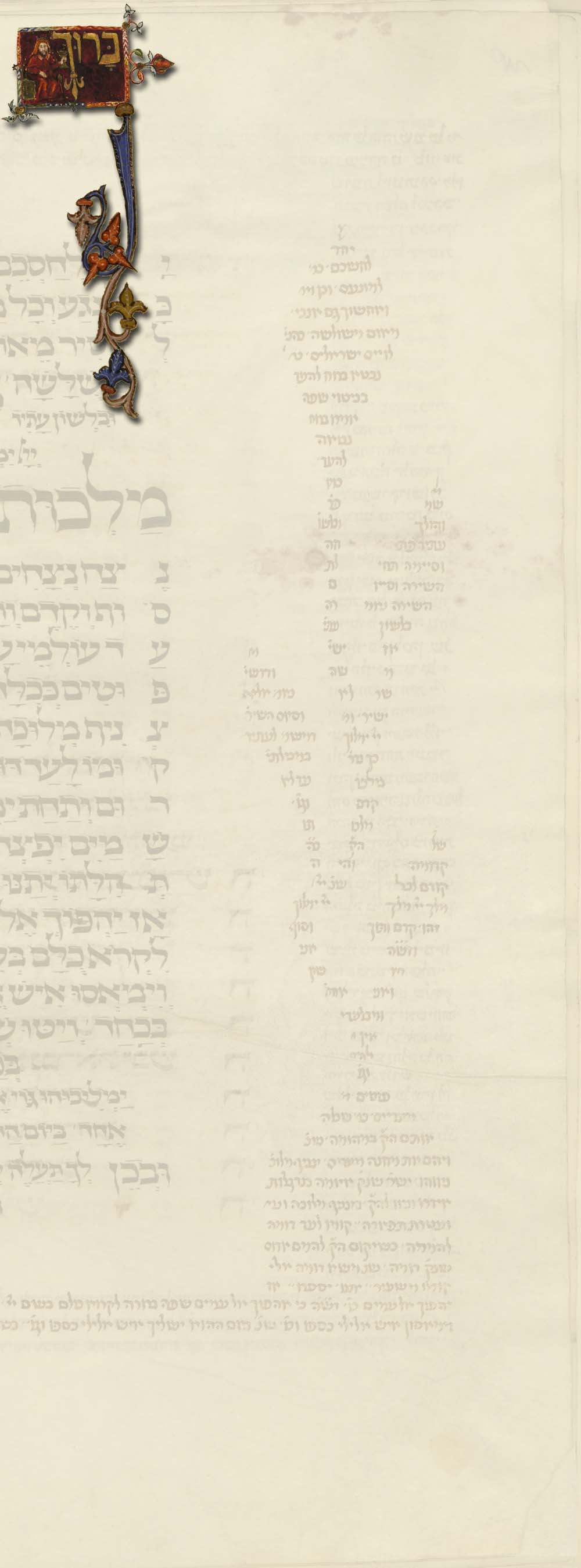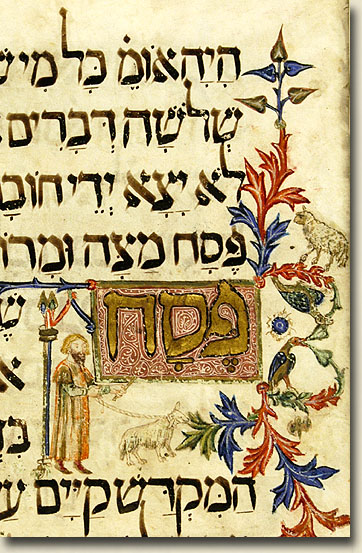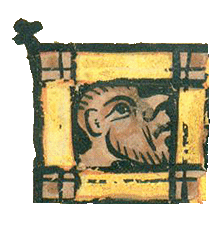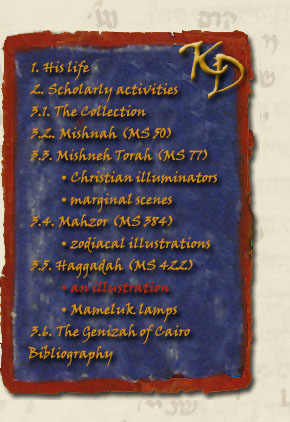



 From among the illustrations on
Biblical themes – although originally they did not form part of Haggadahs – we
select two intriguing scenes from Moses' childhood when he was living at
Pharaoh's court (f.9v). These scenes do not appear
in the Bible itself but have been preserved in the rich treasury of Jewish
legend. 203
For a detailed description of these scenes we turn to Gabrielle
Sed-Rajna:
From among the illustrations on
Biblical themes – although originally they did not form part of Haggadahs – we
select two intriguing scenes from Moses' childhood when he was living at
Pharaoh's court (f.9v). These scenes do not appear
in the Bible itself but have been preserved in the rich treasury of Jewish
legend. 203
For a detailed description of these scenes we turn to Gabrielle
Sed-Rajna:
Upper
compartment: Moses taking off Pharaoh's crown. Pharaoh was dining one day in the company of his daughter and Moses. Pharaoh's
daughter, wearing a gold diadem, is seated on the right, the crowned Pharaoh in
the center and between them the young Moses wearing also a crown. During the
dinner, the playful child took off the king's crown. This is the gesture which
is evoked in the painting. Pharaoh's wise men interpret the gesture of the child
as an evil omen. Pharaoh hence decided to call for all the wise men of Egypt in
order to decide whether the child acted as an innocent infant or with wisdom,
revealing his ambition to take over the kingdom from Pharaoh. The painting shows
the three councillors in a lively discussion, one of them holding a scroll which
might have been inscribed, but is blank at present.
Lower
compartment: The test of Moses. Knowing that Moses was in danger, God sent the angel Gabriel disguised as one of
the wise men. When
 they were asked to give their opinion, Gabriel suggested that
the child should be tested: an onyx stone and a vessel of live coal should be
placed before him. If he stretches out his hand to grasp the onyx, which is the
symbol of power, it proves that the child acted with wisdom and he has to be
killed. But if he chose the burning coal his innocence would become evident and
he could live. The image depicts the test: on the right the enthroned Pharaoh
with a vessel full of gold on his lap; in front of him the young Moses and
Gabriel descending from a cloud guiding the child's hand toward the vessel of
burning coal. The coal burned the child's hand, so he lifted it up and touched
his mouth. By doing so he burned his lips and tongue. That is why he became
“slow of speech” for all his life (Exodus 4:10). His life, however, was safe.
Pharaoh's councillors are watching the scene on the left. 204
they were asked to give their opinion, Gabriel suggested that
the child should be tested: an onyx stone and a vessel of live coal should be
placed before him. If he stretches out his hand to grasp the onyx, which is the
symbol of power, it proves that the child acted with wisdom and he has to be
killed. But if he chose the burning coal his innocence would become evident and
he could live. The image depicts the test: on the right the enthroned Pharaoh
with a vessel full of gold on his lap; in front of him the young Moses and
Gabriel descending from a cloud guiding the child's hand toward the vessel of
burning coal. The coal burned the child's hand, so he lifted it up and touched
his mouth. By doing so he burned his lips and tongue. That is why he became
“slow of speech” for all his life (Exodus 4:10). His life, however, was safe.
Pharaoh's councillors are watching the scene on the left. 204
203 See
Scheiber 1957. 17-18. Id.:
Korona és parázs. [=Crown and embers]. In:
Id.: Folklór és
tárgytörténet [~Studies in folklore]. Budapest 1977-1984. III.
486-489. One of the main sources is Josephus Flavius' Antiquitates
Iudaicae (II. IX, 7). There, however, the story differs somewhat
from the version depicted here.
Flavius Josephus: Jüdische Altertümer. Übersetzt von
Heinrich Clementz. 7. Aufl.
Wiesbaden 1987. I. 113. In general, see Joseph
Gutmann: The testing of
Moses: A comparative study in Christian, Muslim and Jewish art. In:
Bulletin of the Asia Institute (Detroit, Michigan). N.S. 2 (1988)
107-117. [Reprinted in:
Gutmann 1989. XIV.
107-117].
204 Gabrielle
Sed-Rajna: The Kaufmann
Haggadah. Budapest 1990. 24-25, 35-36. Cf.
Müller – von Schlosser:
Bilderhaggaden 1898. 193-194.
Scheiber 1957. 17. Gutmann 1960. 18*-19*.
This page illustrates the general condition of our manuscript. The
illustration in the upper compartment appears in the Second Nürnberg
Haggadah. Müller – von Schlosser:
Bilderhaggaden 1898. 138-139 [Fol. 9], Tafel XX.
Narkiss – Sed-Rajna 1981. Cards Nos 43-44. Cf. also
Kaufmann: Bilderzyklen.
In: Kaufmann 1908-1915.
III. 242 [ad F. 8b].
Sed-Rajna 1987. 92. Cf.
Réau 1955-1959. II. I. 182-183.
